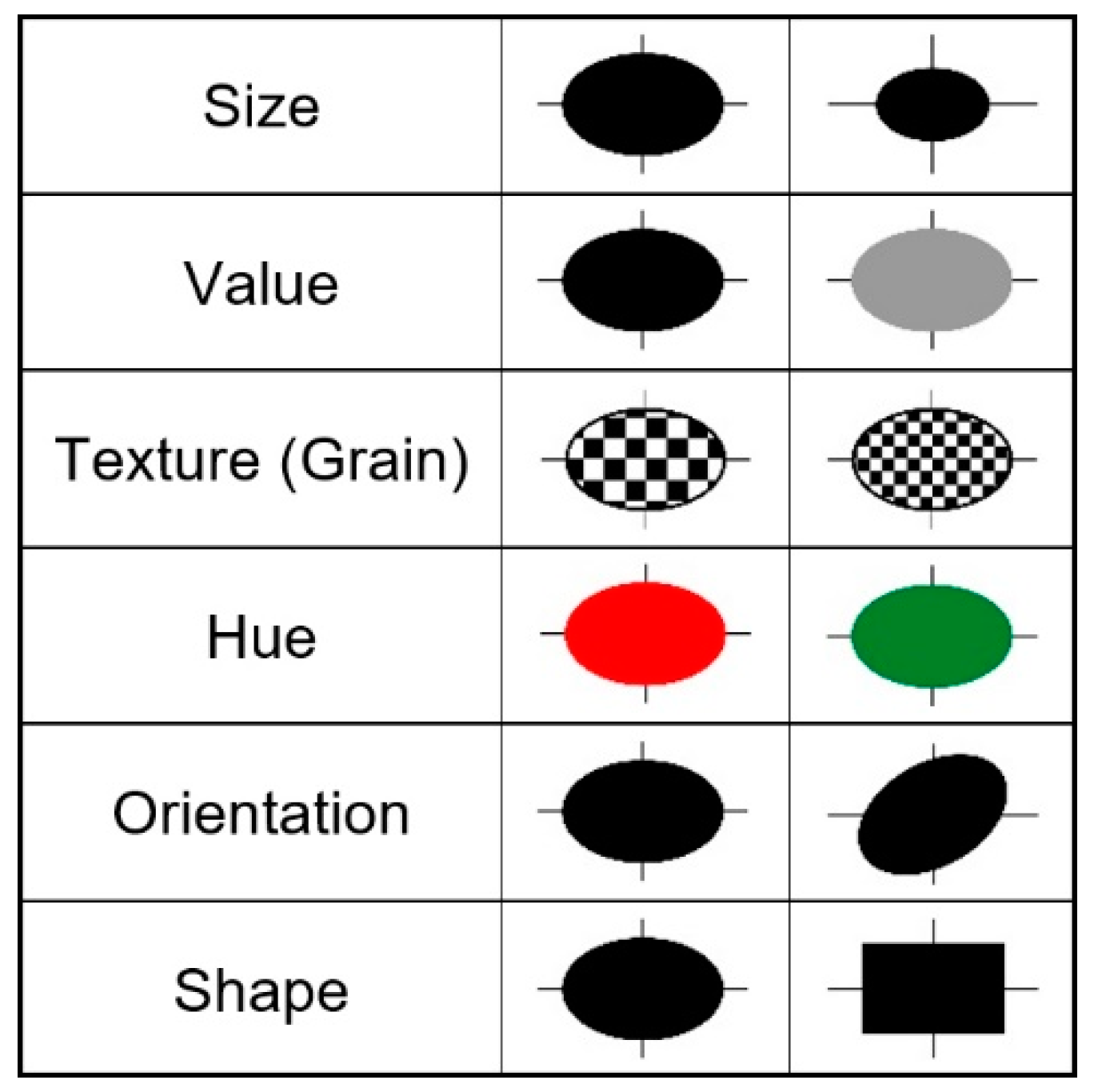Effect of Size, Shape and Map Background in Cartographic Visualization: Experimental Study on Czech and Chinese Populations
Abstract
:1. Introduction
- Size (taille): variation in the area size covered by a sign at a constant shape
- Value (valeur): variation in the ratio of the total amount of black and white in the perceived color of a given area
- Texture (grain): variation in the amount of discernable uniform marks per unit area at a constant value (there should be no variation in value, which is often ignored in the literature about Bertin’s variables)
- Hue (couleur): wavelength variation within the visible part of the electromagnetic spectrum between two areas at a constant value
- Orientation (orientation): angular difference between several arrays of parallel signs
- Shape (forme): variation in the outline character (form) of a sign at a constant size
2. Perception
3. Research on Graphic Variables in Cartography
4. Cross-Cultural Research and Cartography
5. Materials and Methods
5.1. Experiment
- Greater complexity of the map background significantly decreases the speed of processing map stimuli during the search task.
- Increasing size significantly increases the speed of processing map stimuli during the search task.
- The shape of the point symbol does not significantly influence the speed of processing map stimuli during the search task.
- Chinese are faster than Czechs in search tasks performed with small map stimuli.
5.2. Stimuli
5.3. Participants
5.4. Procedure
6. Results
7. Discussion and Conclusions
Author Contributions
Funding
Acknowledgments
Conflicts of Interest
References
- Bandrova, T.; Konečný, M.; Zlatanova, S. Disaster management in practice—Concerning 5th ICC&GIS flood and evacuation of 92 participants. In Proceedings of the 6th International Conference on Cartography & GIS, Albena, Bulgaria, 13–17 June 2016; Bandrova, T., Konečný, M., Eds.; Bulgarian Cartographic Association: Sofia, Bulgaria, 2016; Volume 2, pp. 770–780. Available online: http://iccgis2016.cartography-gis.com/iccgis2016/wp-content/uploads/2016/08/ICCGIS2016_PROCEEDINGS-HQ.pdf (accessed on 7 September 2018).
- Black, J.; Arrowsmith, C.; Black, M.; Cartwright, W. Comparison of Techniques for Visualising Fire Behaviour. Trans. GIS 2007, 11, 621–635. [Google Scholar] [CrossRef]
- Bertin, J. Graphische Semiologie: Diagramme, Netze, Karten; Translated from the 2nd French Edition (1973); Walter de Gruyter: Berlin, Germany, 1974; ISBN 3-11-003660-6. [Google Scholar]
- Caivano, J.L. Visual texture as a semiotic system. Semiotica 1990, 80, 239–252. [Google Scholar] [CrossRef]
- Carpendale, M.S.T. Considering Visual Variables as a Basis for Information Visualization, Research Report 2001-693-16; University of Calgary: Calgary, AB, Canada, 2003; Available online: http://innovis.cpsc.ucalgary.ca/innovis/uploads/Publications/Publications/Carpendale-VisualVariablesInformationVisualization.2003.pdf (accessed on 9 September 2018).
- Halík, Ł. The analysis of visual variables for use in the cartographic design of point symbols for mobile Augmented Reality applications. Geod. Cartogr. 2012, 61, 19–30. [Google Scholar] [CrossRef] [Green Version]
- Keates, J.S. Cartographic Design and Production, 1st ed.; Longman Group: London, UK, 1973; ISBN 0-582-48283-6. [Google Scholar]
- MacEachren, A.M. How Maps Work: Representation, Visualization, and Design, 1st ed.; Guilford Press: New York, NY, USA, 1995; ISBN 0-89862-589-0. [Google Scholar]
- Morrison, J.L. A theoretical framework for cartographic generalization with the emphasis on the process of symbolization. Int. Yearb. Cartogr. 1974, 14, 115–127. [Google Scholar]
- Roth, R. Visual variables. In International Encyclopedia of Geography: People, the Earth, Environment and Technology; Wiley: New York, NY, USA, 2017. [Google Scholar]
- Spiess, E. Eigenschaften von Kombinationen graphischer Variablen. In Grundsatzfragen der Kartographie, 1st ed.; Arnberger, E., Ed.; Österreichische Geographische Gesellschaft: Vienna, Austria, 1970; pp. 280–293. [Google Scholar]
- Swienty, O.; Zhang, M.; Reichenbacher, T.; Meng, L. Establishing a neurocognition-based taxonomy of graphical variables for attention-guiding geovisualisation. In Proceedings of the SPIE-Geoinformatics 2007: Cartographic Theory and Models, Nanjing, China, 3 August 2007; Li, M., Wang, J., Eds.; Volume 6751, pp. 1–13. [Google Scholar]
- Tyner, J.A. Principles of Map Design, 1st ed.; Guilford Press: New York, NY, USA, 2010; ISBN 978-1-60623-544-7. [Google Scholar]
- Burian, J.; Brychtová, A.; Vávra, A.; Hladišová, B. Analytical Material for Planning in Olomouc, Czech Republic. J. Maps 2016, 12, 649–654. [Google Scholar] [CrossRef]
- Kessler, F.C.; Slocum, T.A. Analysis of thematic maps published in two geographical journals in the twentieth century. Ann. Assoc. Am. Geogr. 2011, 101, 292–317. [Google Scholar] [CrossRef]
- White, T.M.; Slocum, T.A.; McDermott, D. Trends and Issues in the Use of Quantitative Color Schemes in Refereed Journals. Ann. Am. Assoc. Geogr. 2017, 107, 829–848. [Google Scholar] [CrossRef]
- Wood, D. Now and then: Comparisons of ordinary Americans’ symbol conventions with those of past cartographers. Prologue 1977, 9, 151–161. Available online: https://babel.hathitrust.org/cgi/pt?id=mdp.39015014516770;view=1up;seq=183 (accessed on 9 September 2018).
- MacEachren, A.M. (Re)Considering Bertin in the Age of Big Data and Visual Analytics. Presented at the 28th International Cartographic Conference, Washington DC, USA, 2–7 July 2017. [Google Scholar]
- Christophe, S.; Hoarau, C. Expressive Map Design Based on Pop Art: Revisit of Semiology of Graphics? Cartogr. Perspect. 2012, 73, 61–74. Available online: https://www.researchgate.net/publication/257935475_Expressive_Map_Design_Based_on_Pop_Art_Revisit_of_Semiology_of_Graphics (accessed on 9 September 2018). [CrossRef]
- Angsüsser, S. Kartenicons im Interkulturellen Vergleich. Kartosemiotische Untersuchung Anhand Gedruckter Deutscher Und Chinesischer Stadtpläne. Ph.D. Thesis, Technische Universität München, München, Germany, 2011. Available online: http://mediatum.ub.tum.de/doc/1084383/1084383.pdf (accessed on 9 September 2018).
- Robinson, A.H.; Morrison, J.L.; Muehrcke, P.C.; Kimerling, A.J.; Guptill, S.C. Elements of Cartography, 6th ed.; John Wiley & Sons: New York, NY, USA, 1995; ISBN 0-471-55579-7. [Google Scholar]
- Slocum, T.A.; McMaster, R.B.; Kessler, F.C.; Howard, H.H. Thematic Cartography and Geovisualization, 3rd ed.; Pearson/Prentice Hall: Upper Saddle River, NJ, USA, 2009; ISBN 978-0-13-229834-6. [Google Scholar]
- Gescheider, G. Psychophysics: The Fundamentals, 3rd ed.; Lawrence Erlbaum Associates: Mahwah, NJ, USA, 1997; ISBN 0-8058-2281-X. [Google Scholar]
- Pinna, B. New Gestalt Principles of Perceptual Organization: An Extension from Grouping to Shape and Meaning. Gestalt Theory 2010, 32, 11–78. Available online: https://pdfs.semanticscholar.org/f54b/87e262bae5daeeab0cc5a17a36318af4537c.pdf (accessed on 9 September 2018).
- Carvalho, G.A.; Moura, A.C.M. Applying Gestalt Theories and Graphical Semiology as Visual Reading Systems Supporting Thematic Cartography. In Proceedings of the 24th International Cartographic Conference, Santiago, Chile, 15–21 November 2009; Available online: http://icaci.org/files/documents/ICC_proceedings/ICC2009/html/refer/20_4.pdf (accessed on 9 September 2018).
- Wagemans, J.; Elder, J.H.; Kubovy, M.; Palmer, S.E.; Peterson, M.A.; Singh, M.; von der Heydt, R. A century of Gestalt psychology in visual perception: I. Perceptual grouping and figure-ground organization. Psychol. Bull. 2012, 138, 1172–1217. [Google Scholar] [CrossRef] [PubMed]
- Beck, D.M.; Palmer, S.E. Top-down influences on perceptual grouping. J. Exp. Psychol. Hum. 2002, 28, 1071–1084. [Google Scholar] [CrossRef]
- Neisser, U. Cognitive Psychology, 1st ed.; Appleton-Century-Crofts: New York, NY, USA, 1967; ISBN 978-0131396678. [Google Scholar]
- Cavanagh, P.; Arguin, M.; Treisman, A. Effect of surface medium on visual search for orientation and size features. J. Exp. Psychol. Hum. 1990, 16, 479–491. [Google Scholar] [CrossRef]
- Treisman, A.; Gormican, S. Feature analysis in early vision: evidence from search asymmetries. Psychol. Rev. 1988, 95, 15–48. [Google Scholar] [CrossRef] [PubMed]
- Brunswik, E. Representative design and probabilistic theory in a functional psychology. Psychol. Rev. 1955, 62, 193–217. [Google Scholar] [CrossRef] [PubMed]
- Dhami, M.K.; Hertwig, R.; Hoffrage, U. The Role of Representative Design in an Ecological Approach to Cognition. Psychol. Bull. 2004, 130, 959–988. [Google Scholar] [CrossRef] [PubMed]
- Montello, D.R. Cognitive Map-Design Research in the Twentieth Century: Theoretical and Empirical Approaches. Cartogr. Geogr. Inf. Sci. 2002, 29, 283–304. [Google Scholar] [CrossRef]
- Koláčný, A. Utilitární kartografie, cesta k optimální účinnosti kartografické informace. Geod. Kartogr. Obz. 1969, 15, 301–308. [Google Scholar]
- Deeb, R.; De Maeyer, P.; Ooms, K. The influence of Jacques Bertin. In Proceedings of the 25th International Cartographic Conference, Paris, France, 3–8 July 2011; Available online: http://icaci.org/files/documents/ICC_proceedings/ICC2011/Oral%20Presentations%20PDF/B1-Graphical%20Semiology,%20visual%20variables/CO-081.pdf (accessed on 9 September 2018).
- Garlandini, S.; Fabrikant, S.I. Evaluating the Effectiveness and Efficiency of Visual Variables for Geographic Information Visualization. In Proceedings of the International Conference on Spatial Information Theory 2009, Aber Wrac’h, France, 21–25 September 2009; Volume 5756, pp. 195–211. [Google Scholar]
- Reimer, A. Squaring the Circle? Bivariate Colour maps and Jacques Bertin’s concept of ‘Disassociation’. In Proceedings of the 25th International Cartographic Conference, Paris, France, 3–8 July 2011; Available online: http://icaci.org/files/documents/ICC_proceedings/ICC2011/Oral%20Presentations%20PDF/A4-Jacques%20Bertin%20and%20graphic%20semiology%202/CO-054.pdf (accessed on 9 September 2018).
- Rundstrom, R.A. Introduction. Cartographica 1993, 30, 32–37. [Google Scholar]
- Harley, J.B.; Blakemore, M.J. Cultural Meaning: The Iconography of Maps. Cartographica 1980, 17, 76–86. [Google Scholar]
- Wood, D. Cultured symbols: Thoughts on the cultural context of cartographic symbols. Cartographica 1984, 21, 9–37. [Google Scholar] [CrossRef]
- Wood, D.; Fels, J. Designs on Signs/Myth and Meaning in Maps. Cartographica 1986, 23, 54–103. [Google Scholar] [CrossRef]
- Tang, X.; Hurni, L. Regional Spatial Planning Maps: A Sino-Swiss Comparison of Cartographic Visualization Methodologies. In Proceedings of the 24th International Cartographic Conference, Santiago, Chile, 15–21 November 2009; Available online: https://icaci.org/files/documents/ICC_proceedings/ICC2009/html/nonref/22_2.pdf (accessed on 9 September 2018).
- Stachoň, Z.; Šašinka, Č.; Čeněk, J.; Štěrba, Z.; Angsuesser, S.; Fabrikant, S.I.; Štampach, R.; Morong, K. Cross-cultural differences in figure–ground perception of cartographic stimuli. Cartogr. Geogr. Inf. Sci. 2018. [Google Scholar] [CrossRef]
- Angsüsser, S. Possible Reasons for Size Differences Between Point Symbols in German and Chinese City Maps. In Proceedings of the 5th International Conference on Cartography & GIS, Riviera, Bulgaria, 15–20 June 2014; Bandrova, T., Konecny, M., Eds.; Bulgarian Cartographic Association: Sofia, Bulgaria, 2014; Volume 1, pp. 268–277. Available online: https://cartography-gis.com/docsbca/5ICCandGIS_Proceedings.pdf (accessed on 9 September 2018).
- Carlson, E.R. Generality of order of concept attainment. Psychol. Rep. 1962, 10, 375–380. [Google Scholar] [CrossRef]
- Leifer, A. Ethnic Patterns in Cognitive Tasks. Ph.D. Thesis, Yeshiva University, New York, NY, USA, 1972. [Google Scholar]
- Lesser, G.S.; Fifer, G.; Clark, D.H. Mental abilities of children from different social class and cultural groups. Monogr Soc. Res. Child Dev. 1965, 30, 1–115. [Google Scholar] [CrossRef] [PubMed]
- Lynn, R.; Pagliari, C.; Chan, J. Intelligence in Hong Kong measured for Spearman’s g and the visuospatial and verbal primaries. Intelligence 1988, 12, 423–433. [Google Scholar] [CrossRef]
- Lynn, R. Intelligence in China. Soc. Behav. Personal. 1991, 19, 1–4. [Google Scholar] [CrossRef]
- Jensen, A.R.; Whang, P.A. Speed of accessing arithmetic facts in long-term memory: a comparison of Chinese-American and Anglo-American children. Contemp. Educ. Psychol. 1994, 19, 1–12. [Google Scholar] [CrossRef]
- Choong, Y.; Salvendy, G. Design of Icons for Use by Chinese in Mainland China. Interact. Comput. 1998, 9, 417–430. [Google Scholar] [CrossRef]
- Hsu, S.-H.; Huang, K.-C. Effects of minimal legible size characters on Chinese word recognition. Visible Lang. 2001, 35, 178–191. Available online: https://s3-us-west-2.amazonaws.com/visiblelanguage/pdf/35.2/effects-of-minimal-legible-size-characters-on-chinese-word-recognition.pdf (accessed on 9 September 2018).
- Mo, C.; Yu, M.; Seger, C.; Mo, L. Holistic neural coding of Chinese character forms in bilateral ventral visual system. Brain Lang. 2015, 141, 28–34. [Google Scholar] [CrossRef] [PubMed]
- Nisbett, R.E.; Peng, K.; Choi, I.; Norenzayan, A. Culture and systems of Thought: Holistic Versus Analytic Cognition. Psychol. Rev. 2001, 108, 291–310. [Google Scholar] [CrossRef] [PubMed]
- Nisbett, R.E. The Geography of Thought. How Asians and Westerners Think Differently … and Why, 1st ed.; The Free Press: New York, NY, USA, 2003; ISBN 0-7432-1646-6. [Google Scholar]
- Hofstede, G. Dimensions of national cultures in fifty countries and three regions. In Expiscations in Cross-Cultural Psychology, 1st ed.; Deregowski, J.B., Dziurawiec, S., Annis, R.C., Eds.; Swets and Zeitlinger: Lisse, The Netherlands, 1983; pp. 335–355. [Google Scholar]
- Hofstede, G.; Hofstede, G.J.; Minkov, M. Cultures and Organizations—Software of the Mind. Intercultural Cooperation and Its Importance for Survival, 3rd ed.; McGraw-Hill: New York, NY, USA, 2010; ISBN 978-0071664189. [Google Scholar]
- Faul, F.; Erdfelder, E.; Lang, A.-G.; Buchner, A. G*Power 3: A flexible statistical power analysis program for the social, behavioral, and biomedical sciences. Behav. Res. Methods 2007, 39, 175–191. [Google Scholar] [CrossRef] [PubMed] [Green Version]
- Šašinka, Č.; Morong, K.; Stachoň, Z. The Hypothesis Platform: An Online Tool for Experimental Research into Work with Maps and Behavior in Electronic Environments. ISPRS Int. Geo-Inf. 2017, 6, 407. [Google Scholar] [CrossRef]
- Popelka, S.; Stachoň, Z.; Šašinka, Č.; Doležalová, J. Eyetribe Tracker Data Accuracy Evaluation and Its Interconnection with Hypothesis Software for Cartographic Purposes. Comput. Intell. Neurosci. 2016, 2016, 9172506. [Google Scholar] [CrossRef] [PubMed]
- Dymon, U. An analysis of emergency map symbology. Int. J. Emerg. Manag. 2003, 1, 227–237. [Google Scholar] [CrossRef]
- Leitner, F. Analýza Využitelnosti Geoinformací ze Zdrojů Typu Big data v Procesech Krizového Řízení. Ph.D. Thesis, Masaryk University, Brno, Czech Republic, 2018. Available online: https://is.muni.cz/th/pxb9l/BP_Leitner_qllmmeem.pdf (accessed on 9 September 2018).
- Van de Vijver, F.; Tanzer, N.K. Bias and equivalence in cross-cultural assessment: an overview. Eur. Rev. Appl. Psychol. 2004, 54, 119–135. [Google Scholar] [CrossRef] [Green Version]
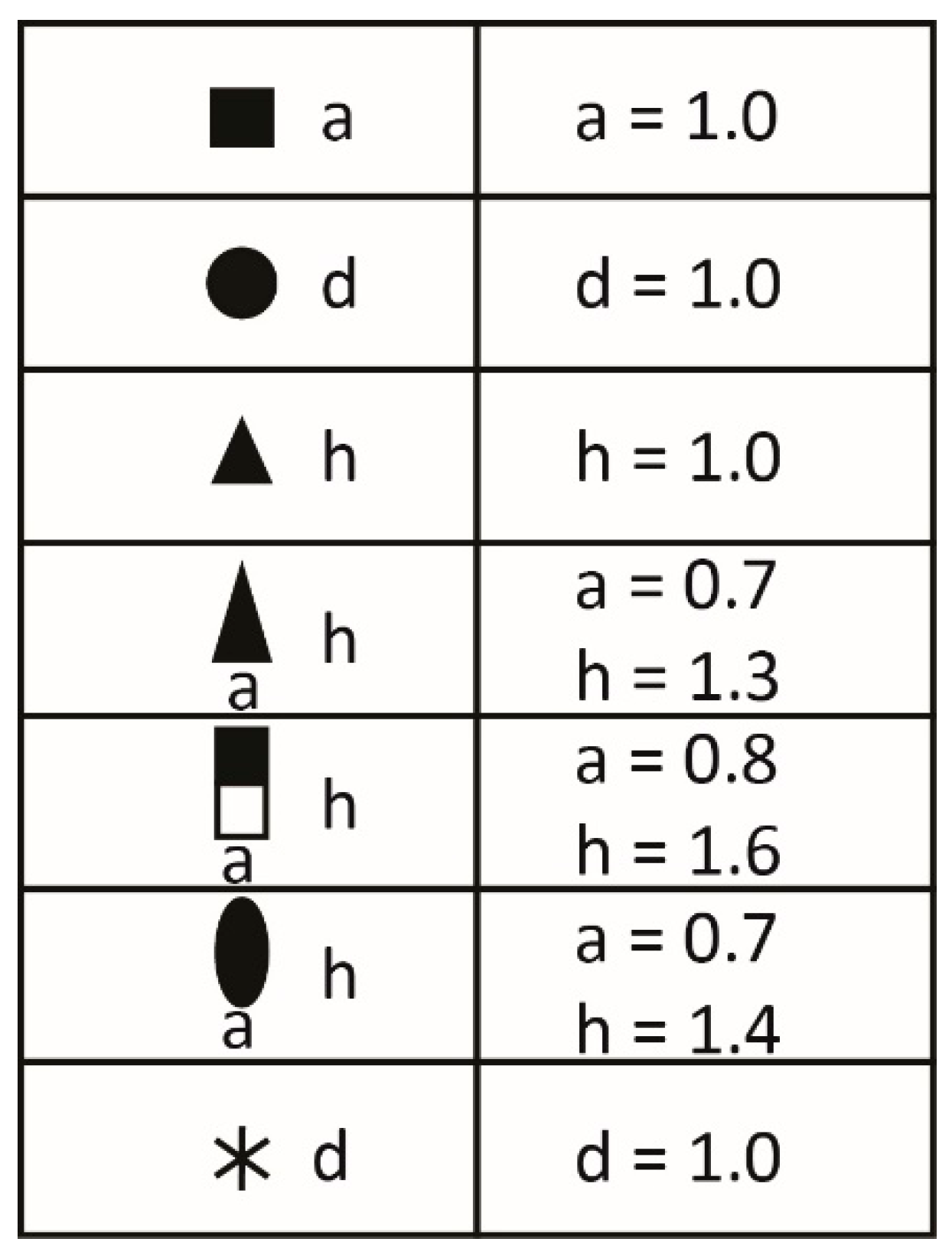
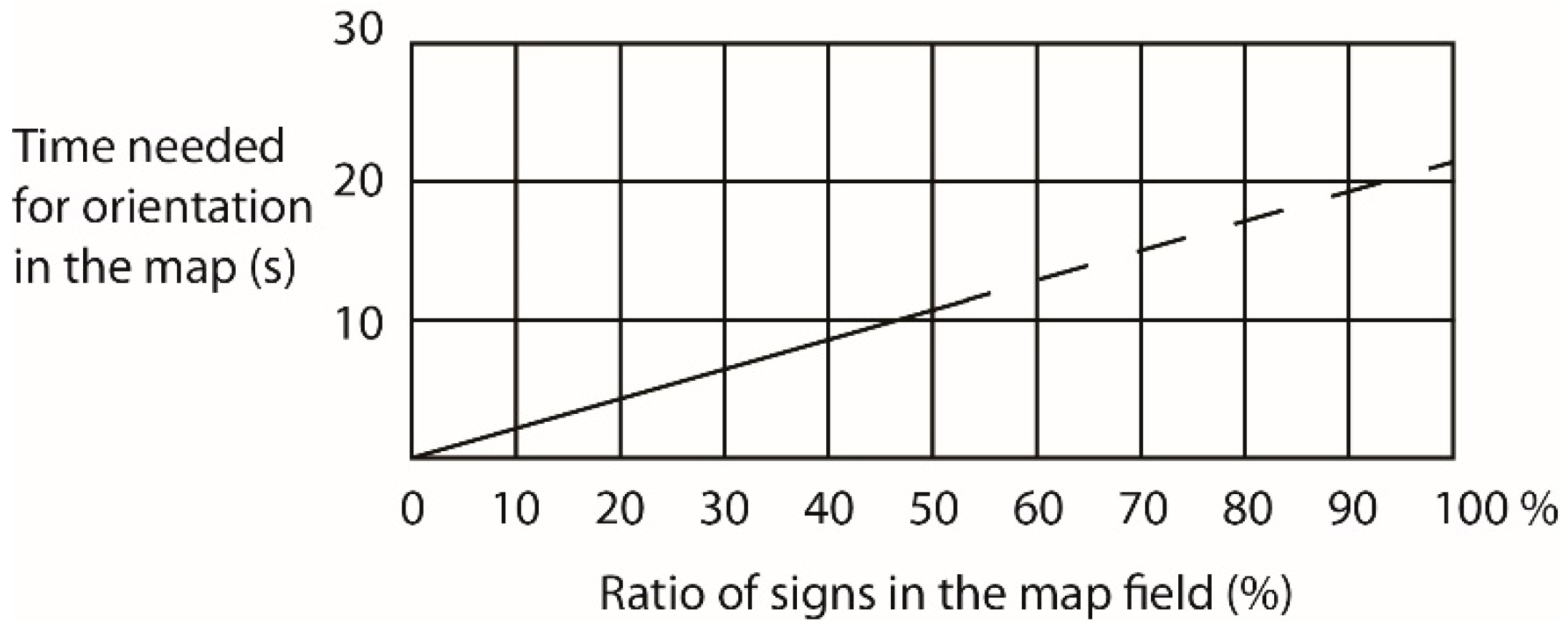
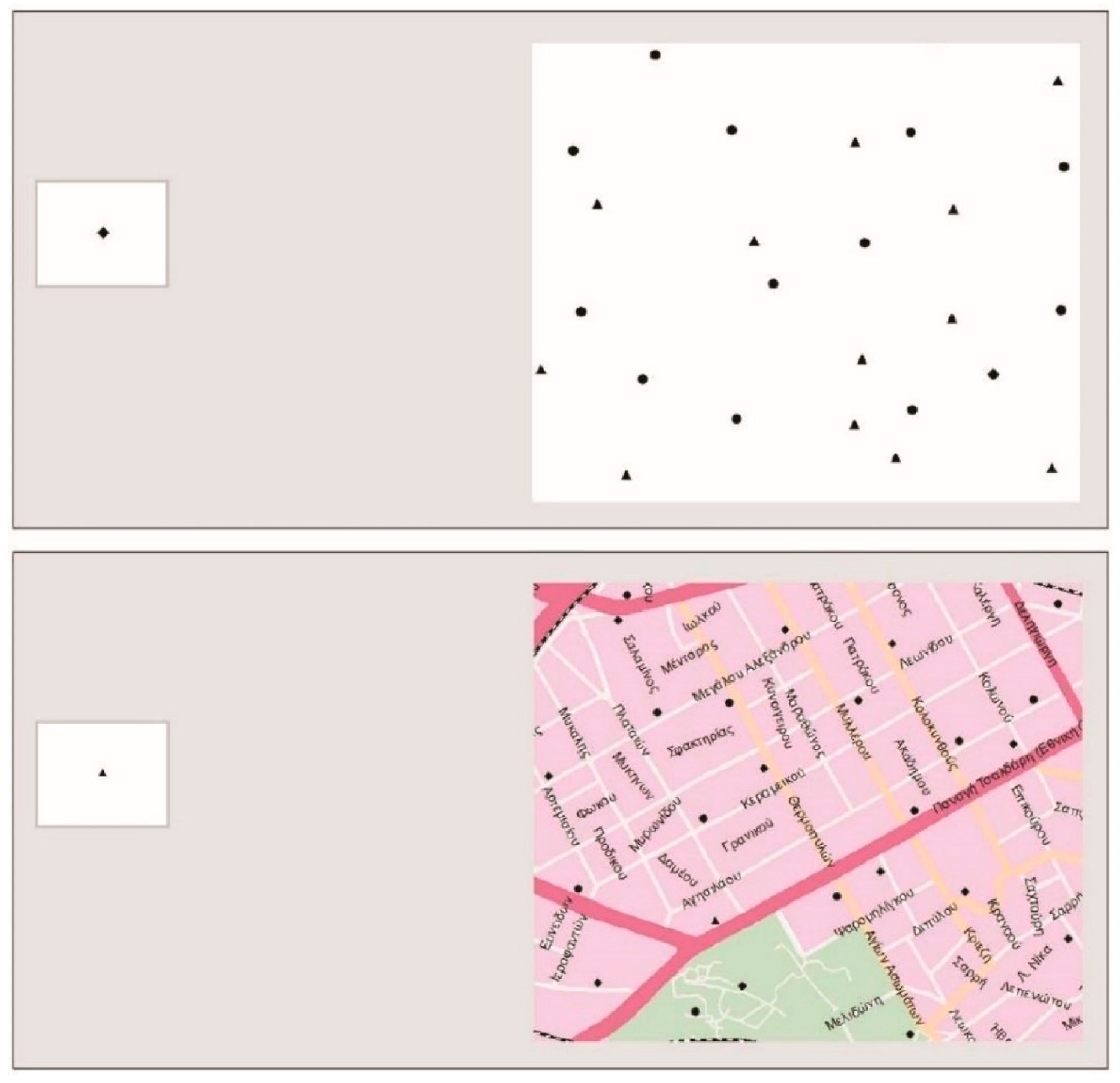

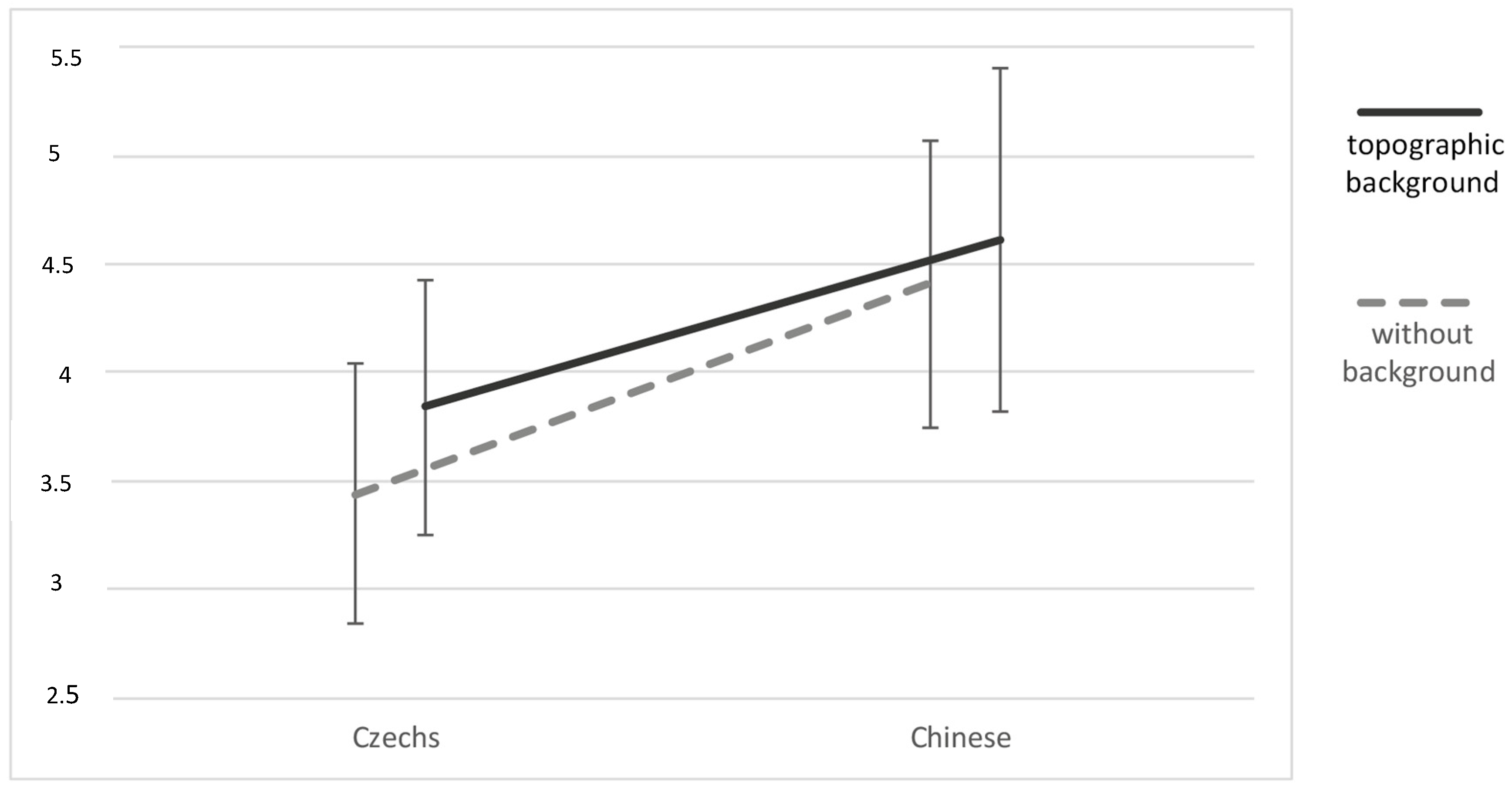

| Shape | Threshold (%) | |
|---|---|---|
| Square |  | 8 |
| Circle |  | 12 |
| Rectangle |  | 12 |
| Equilateral triangle |  | 8 |
| Isosceles triangle |  | 15 |
| Symbol Size | Group | All Shapes: Mean Time (SD) | Circle: Mean Time (SD) | Diamond: Mean Time (SD) | Triangle: Mean Time (SD) |
|---|---|---|---|---|---|
| Small | Chinese | 5.24 (0.93) | 4.88 (0.99) | 7.06 (1.73) | 3.75 (0.52) |
| Czech | 4.19 (0.72) | 3.75 (0.77) | 5.85 (1.57) | 3.12 (0.62) | |
| Total | 4.74 (0.98) | 4.34 (1.05) | 6.48 (1.75) | 3.45 (0.65) | |
| Large | Chinese | 4.25 (0.60) | 3.81 (0.58) | 5.51 (0.96) | 3.75 (0.66) |
| Czech | 3.37 (0.59) | 3.01 (0.49) | 4.15 (1.16) | 3.03 (0.65) | |
| Total | 3.83 (0.74) | 3.43 (0.67) | 4.67 (1.17) | 3.40 (0.75) |
© 2018 by the authors. Licensee MDPI, Basel, Switzerland. This article is an open access article distributed under the terms and conditions of the Creative Commons Attribution (CC BY) license (http://creativecommons.org/licenses/by/4.0/).
Share and Cite
Stachoň, Z.; Šašinka, Č.; Čeněk, J.; Angsüsser, S.; Kubíček, P.; Štěrba, Z.; Bilíková, M. Effect of Size, Shape and Map Background in Cartographic Visualization: Experimental Study on Czech and Chinese Populations. ISPRS Int. J. Geo-Inf. 2018, 7, 427. https://0-doi-org.brum.beds.ac.uk/10.3390/ijgi7110427
Stachoň Z, Šašinka Č, Čeněk J, Angsüsser S, Kubíček P, Štěrba Z, Bilíková M. Effect of Size, Shape and Map Background in Cartographic Visualization: Experimental Study on Czech and Chinese Populations. ISPRS International Journal of Geo-Information. 2018; 7(11):427. https://0-doi-org.brum.beds.ac.uk/10.3390/ijgi7110427
Chicago/Turabian StyleStachoň, Zdeněk, Čeněk Šašinka, Jiří Čeněk, Stephan Angsüsser, Petr Kubíček, Zbyněk Štěrba, and Martina Bilíková. 2018. "Effect of Size, Shape and Map Background in Cartographic Visualization: Experimental Study on Czech and Chinese Populations" ISPRS International Journal of Geo-Information 7, no. 11: 427. https://0-doi-org.brum.beds.ac.uk/10.3390/ijgi7110427




